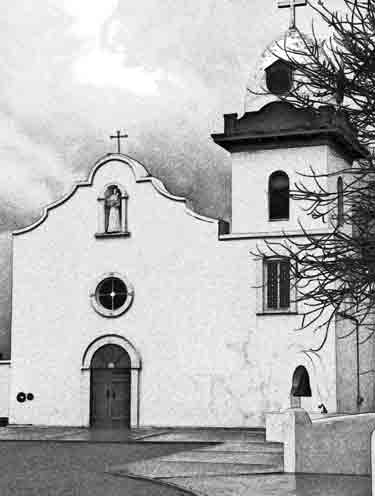Raise a Toast to El Paso del Norte, Fray Garcia de San Francisco and our Modern Texas Wine Industry.
Sacramental wine in early El Paso del Norte apparently had its roots farther north up the Rio Grande in New Mexico. Before Fray Garcia de San Francisco came to El Paso to found the Mission Nuestra Señora de Guadalupe and planted vineyards, he served in San Antonio de Senecú (in present-day New Mexico).
It is reported that as early as the 1630s the Senecú Mission produced wine to supply other missions in New Mexico. To bolster his locally produced wine, his Franciscans also received shipments of wine from Mexico City. These shipments were imported Spanish wine that was intended for use in the sacrements of the Catholic Church. Rumor has it that priests may have sold the more desirable Spanish wine to wealthy passioners and substituted the local wine. As we know, the virtues of wine in the Catholic Church is for its sacramental value in the eyes of God and not for its gustatory experience.
However, the Senecú Mission was short lived due to sever and bloody native distrubances. The missionaries eventually reteated southward to the safer confines of the growing and better-defended settlement and mission in El Paso del Norte and it’s shorter and more stable supply lines to Mexico City. Thus, Fray Garcia de San Francisco brought his winegrowing and winemaking talents to El Paso to claim his birthright as the acclaimed “First Viticulturalist of Texas” albeit in advance of Texas independence from Mexican rule that took place over 150 years later.
Another factor that came to bear that helped wine production in El Paso was a change in Spanish policies with respect to wine production in the Americas. As far back as 1519 under direction of the King of Spain, grapevine cuttings and cuttings and root stock were sent in every ship bound for the New World with the hope of supplying local wine. The efforts to establish a New World wine industry were initially successful. However, in 1595, the king of Spain gave new orders that new plantings or replacements of vineyards in New World were forbidden for fear that the colonies would become self-sufficient in wine production, but it was already too late.
American producers were not permitted to export their wine to any place that could be supplied from Spain, the ban saw only limited enforcement. The aforementioned Spanish prohibition dates from the seventeenth century, precisely the century when Fray Garcia de San Francisco’s planting of vines began at El Paso del Norte. Best we can tell is that the first cuttings were planted in El Paso del Norte in 1659, the time when he founded the mission there. Reportedly the mission was on the southern bank of the Rio Grande in what became Juarez, Mexico, and his vineyards were planted in the dry rocky, clay-rich red soil on the northern shore. This was more than a hundred years before other Spainsh missionaries first brought their winegrowing and wine culture to California.
Wine production in El Paso and even the production of distilled grape spirits (i.e brandy) evolved into the robust business for the Catholic Church. Eventually, the Mexican government secularized this business that continued to florish as a local commercial industry through the 1700s and up to the mid/late-1800s. The journal entries of travelers through the region during that period are explicit about the high quality of the wines and brandies enjoyed by these early Texas tourists.
The rest is history. There was a long period of struggle in Texas involving battles with native tribes for rights to the land, battles of confederate secession and civil war, and battles of prohibition on sales and consumption of alcoholic beverages. These were not supportive of growing a Texas wine culture.
However, nearly every European immigrant farmer that came to Texas in the 1800s brought with them a love of wine and its place in everyday life. These transplants to Texas tried to make wine, some used native grapes and others found hybrid varieties that could withstand disease pressures and a climate of extremes.
It wasn’t until the 1970’s that Texas built on its wine legacy. Modern techology and a more affluent and diverse Texas society gave rise to Texas as the fifth largest wine producing state, the seventh largest grape producing state and fourth largest wine consuming state.
And, let’s have a toast to that….Cheers!
++++++++++
Thanks to Rick Hendricks for his historical narrative titled, “Wine Production in El Paso and the Grapevine Inventory of 1755” utilized in part for this blog. See: http://newmexicohistory.org/people/wine-production-in-el-paso-and-the-grapevine-inventory-of-1775

